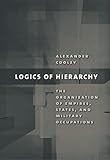Logics of Hierarchy : The Organization of Empires, States, and Military Occupations / Alexander Cooley.
Material type: TextPublisher: Ithaca, NY : Cornell University Press, [2011]Copyright date: ©2012Description: 1 online resource (208 p.) : 14 tables, 11 charts/graphsContent type:
TextPublisher: Ithaca, NY : Cornell University Press, [2011]Copyright date: ©2012Description: 1 online resource (208 p.) : 14 tables, 11 charts/graphsContent type: - 9780801474835
- 9780801462498
- 302.3/5 22
- JZ1310 .C663 2005eb
- online - DeGruyter
- Issued also in print.
| Item type | Current library | Call number | URL | Status | Notes | Barcode | |
|---|---|---|---|---|---|---|---|
 eBook
eBook
|
Biblioteca "Angelicum" Pont. Univ. S.Tommaso d'Aquino Nuvola online | online - DeGruyter (Browse shelf(Opens below)) | Online access | Not for loan (Accesso limitato) | Accesso per gli utenti autorizzati / Access for authorized users | (dgr)9780801462498 |
Frontmatter -- Contents -- List of Figures and Tables -- Preface -- Chapter One. Understanding Hierarchy in International Politics -- Chapter Two. Forms of Hierarchy: The U-form and M-form -- Chapter Three. The Governance of Hierarchy: Paths of Institutional Formation -- Chapter Four. An Empirical Illustration: Soviet Central Asia -- Chapter Five. The Legacies of Hierarchy: Divergent Paths of Extrication -- Chapter Six. Comparative Applications: Yugoslavia, Korea, and Iraq -- Chapter Seven. Hierarchy in a Globalized World -- Index
restricted access online access with authorization star
http://purl.org/coar/access_right/c_16ec
Political science has had trouble generating models that unify the study of the formation and consolidation of various types of states and empires. The business-administration literature, however, has long experience in observing organizations. According to a dominant model in this field, business firms generally take one of two forms: unitary (U) or multidivisional (M). The U-form organizes its various elements along the lines of administrative functions, whereas the M-form governs its periphery according to geography and territory.In Logics of Hierarchy, Alexander Cooley applies this model to political hierarchies across different cultures, geographical settings, and historical eras to explain a variety of seemingly disparate processes: state formation, imperial governance, and territorial occupation. Cooley illustrates the power of this formal distinction with detailed accounts of the experiences of Central Asian republics in the Soviet and post-Soviet eras, and compares them to developments in the former Yugoslavia, the governance of modern European empires, Korea during and after Japanese occupation, and the recent U.S. occupation of Iraq.In applying this model, Logics of Hierarchy reveals the varying organizational ability of powerful states to promote institutional transformation in their political peripheries and the consequences of these formations in determining pathways of postimperial extrication and state-building. Its focus on the common organizational problems of hierarchical polities challenges much of the received wisdom about imperialism and postimperialism.
Issued also in print.
Mode of access: Internet via World Wide Web.
In English.
Description based on online resource; title from PDF title page (publisher's Web site, viewed 02. Mrz 2022)


